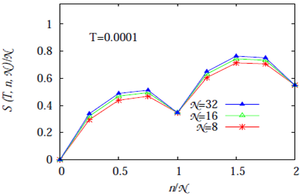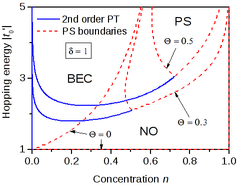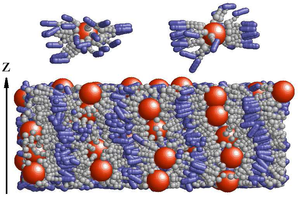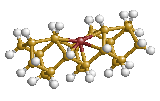Research / Annual reports / Main research results of the Institute for Condensed Matter Physics of NAS of Ukraine in 2010
Main research results of the Institute for Condensed Matter Physics of NAS of Ukraine in 2010
a) Main fundamental results
 A new approach to analysis of collective dynamics in glass systems was proposed that permits treatment of specific for glasses slow relaxation processes. The approach was applied to analysis of molecular dynamics simulations performed for a metallic binary glass Mg70Zn30, that alowed to reproduce all features of partial time correlation functions density-density as well as obtain dispersion and damping of acoustic, optic excitations and ultralow-frequency collective modes that form an excess on density of vibrational states known as Boson peak.It was shown for the first time that the collective processes responsible for formation of Boson peak are pronouncely reflected in the shape of concentration dynamic structure factors. These results give evidence of non-acoustic origin of Boson peak in glass systems. (T.Bryk, I.Mryglod).
A new approach to analysis of collective dynamics in glass systems was proposed that permits treatment of specific for glasses slow relaxation processes. The approach was applied to analysis of molecular dynamics simulations performed for a metallic binary glass Mg70Zn30, that alowed to reproduce all features of partial time correlation functions density-density as well as obtain dispersion and damping of acoustic, optic excitations and ultralow-frequency collective modes that form an excess on density of vibrational states known as Boson peak.It was shown for the first time that the collective processes responsible for formation of Boson peak are pronouncely reflected in the shape of concentration dynamic structure factors. These results give evidence of non-acoustic origin of Boson peak in glass systems. (T.Bryk, I.Mryglod).
 Phase transition into the phase with Bose-Einstein (BE) condensate in the lattice Bose-gas with the particle hopping in the excited band only is investigated in the hard-core limit. The study is based on the Bose-Hubbard model which is used in the theory of ionic conductors and optical lattices with ultracold atoms as well as for description of the quantum delocalization of particles adsorbed on the metal surface. It has been proved, that order of the phase transition can change from the second to the first one at variation of the excitation energy, chemical potential of particles and temperature. The conditions are found at which the separation on the normal phase and phase with the BE condensate takes place. ( I.V. Stasyuk, O.V. Velychko)
Phase transition into the phase with Bose-Einstein (BE) condensate in the lattice Bose-gas with the particle hopping in the excited band only is investigated in the hard-core limit. The study is based on the Bose-Hubbard model which is used in the theory of ionic conductors and optical lattices with ultracold atoms as well as for description of the quantum delocalization of particles adsorbed on the metal surface. It has been proved, that order of the phase transition can change from the second to the first one at variation of the excitation energy, chemical potential of particles and temperature. The conditions are found at which the separation on the normal phase and phase with the BE condensate takes place. ( I.V. Stasyuk, O.V. Velychko)
New conception for construction of perturbation technique for liquids free energy calculation was formulated. The criterion for the choice of reference system is equality of excluded volume of reference and total systems. Proposed approach guarantees fast convergence of the series allowing to get good results in all temperature range even in the first approximation. Approach was effectively used for investigation of a number of systems what can be described by models of Sutherland and Buckingham. It was shown that Yukawa model is more universal than hard sphere model for describing of reference system and therefore can be utilized for very wide spectrum of liquid systems (Trokhymchuk A., Melnyk R.).
Using the rigorous relations for mutual diffusion coefficients, derived previously for a multi-component fluid, the exact relation for generalized (k,ω)-dependent partial conductivities of pseudo-binary molten salts and electrolyte solution in neutral solvent are obtained. These results are generalized for a case of multi-component ionic fluids with arbitrary charges of ions. The derived relation gives the most general form of known “universal golden rule” discovered experimentally for binary molten salts more than 50 years ago by Sundheim (I.M.Mryglod, V.M.Kuporov).
 The logarithmic corrections to the leading power laws that govern thermodynamic quantities as a second-order phase transition point is approached have been analyzed. For phase transitions of spin systems on d-dimensional lattices, such corrections appear at some marginal values of the order parameter or space dimension. Scaling relations for these exponents have been obtained. A spin system on a scale-free network which exhibits logarithmic corrections due to the specific network properties was considered. For the scale-free networks the logarithmic corrections appear at marginal values of the node degree distribution exponent. In addition we have calculated scaling functions, which also exhibit nontrivial dependence on intrinsic network properties. (Holovatch Yu., Palchykov V.).
The logarithmic corrections to the leading power laws that govern thermodynamic quantities as a second-order phase transition point is approached have been analyzed. For phase transitions of spin systems on d-dimensional lattices, such corrections appear at some marginal values of the order parameter or space dimension. Scaling relations for these exponents have been obtained. A spin system on a scale-free network which exhibits logarithmic corrections due to the specific network properties was considered. For the scale-free networks the logarithmic corrections appear at marginal values of the node degree distribution exponent. In addition we have calculated scaling functions, which also exhibit nontrivial dependence on intrinsic network properties. (Holovatch Yu., Palchykov V.).
 The low-temperature properties of the electronic Hubbard model and quantum Heisenberg antiferromagnet on a class of lattices with triangular traps have been studied. A wide class of eigenstates of these models can be described as the states which are localized in triangular traps. Moreover, these states have two-fold degeneracy due to the chirality of the triangle. We have constructed exactly many-body ground states and some of the low-lying excited states of the studied models, counted the degeneracy and their contribution to the low-temperature thermodynamics. The effect of additional interactions which lift the degeneracy with respect to the chirality has been discussed. The low-temperature thermodynamics in this case has been examined too. It has been demonstrated that the additional interactions give rise to an effective (pseudo)spin-1/2 XX chain describing the chirality spreading over the lattice as a spin wave. Manipulations with chirality may have applications for quantum computing. (Maksymenko M., Derzhko O.)
The low-temperature properties of the electronic Hubbard model and quantum Heisenberg antiferromagnet on a class of lattices with triangular traps have been studied. A wide class of eigenstates of these models can be described as the states which are localized in triangular traps. Moreover, these states have two-fold degeneracy due to the chirality of the triangle. We have constructed exactly many-body ground states and some of the low-lying excited states of the studied models, counted the degeneracy and their contribution to the low-temperature thermodynamics. The effect of additional interactions which lift the degeneracy with respect to the chirality has been discussed. The low-temperature thermodynamics in this case has been examined too. It has been demonstrated that the additional interactions give rise to an effective (pseudo)spin-1/2 XX chain describing the chirality spreading over the lattice as a spin wave. Manipulations with chirality may have applications for quantum computing. (Maksymenko M., Derzhko O.)
 A coarse-grained simulation model for a third generation liquid crystalline dendrimer (LCDr) is developed. It allows, for the firrst time, for a successful molecular simulation study of a relation between the shape of a polyphilic macromolecular mesogen and the symmetry of a macroscopic phase. The model dendrimer consists of a soft central sphere and 32 grafted chains each terminated by a mesogen group. The latter interact via the Lintuvuori-Wilson potential. Coarse-grained molecular dynamics simulations are performed on a melt of 100 molecules in the anisotropic-isobaric ensemble. The model LCDr shows conformational bistability, with both rod-like and disc-like conformations stable at lower temperatures. Each conformation can be induced by an external aligning field of appropriate symmetry leading to spontaneous formation of either a monodomain smectic A or a columnar phase, respectively. Both phases are stable for approximately the same temperature range and both exhibit a sharp transition to an isotropic cubic-like phase upon heating. We observe a very strong coupling between the conformation of the LCDr and the symmetry of a bulk phase (J.Ilnytskyi, J.Lintuvuori, M.R.Wilson).
A coarse-grained simulation model for a third generation liquid crystalline dendrimer (LCDr) is developed. It allows, for the firrst time, for a successful molecular simulation study of a relation between the shape of a polyphilic macromolecular mesogen and the symmetry of a macroscopic phase. The model dendrimer consists of a soft central sphere and 32 grafted chains each terminated by a mesogen group. The latter interact via the Lintuvuori-Wilson potential. Coarse-grained molecular dynamics simulations are performed on a melt of 100 molecules in the anisotropic-isobaric ensemble. The model LCDr shows conformational bistability, with both rod-like and disc-like conformations stable at lower temperatures. Each conformation can be induced by an external aligning field of appropriate symmetry leading to spontaneous formation of either a monodomain smectic A or a columnar phase, respectively. Both phases are stable for approximately the same temperature range and both exhibit a sharp transition to an isotropic cubic-like phase upon heating. We observe a very strong coupling between the conformation of the LCDr and the symmetry of a bulk phase (J.Ilnytskyi, J.Lintuvuori, M.R.Wilson).
b) Main applied results
 Using quantum-chemical calculations and density-functional theory the structure of H-passivated silicon surface Si(001), which is obtained at fabrication of nanopore silicon, is investigated. Copper adsorption on this surface is investigated and energetically favourable adsorption sites are revealed. Charge distribution in the system and reconstuction of the surface at adsorption are analysed. (Mysakovych T.S).
Using quantum-chemical calculations and density-functional theory the structure of H-passivated silicon surface Si(001), which is obtained at fabrication of nanopore silicon, is investigated. Copper adsorption on this surface is investigated and energetically favourable adsorption sites are revealed. Charge distribution in the system and reconstuction of the surface at adsorption are analysed. (Mysakovych T.S).
We have performed the DFT-studies of surface and subsurface layers of Fe-Cr alloys of two different types which corresponds: (1) to the substitutional alloys with Cr substituting Fe atoms; (2) to the proposed novel type interstitial Fe-Cr alloys with the Cr atoms located in the centers of adges of the cubic bcc unit cells of Fe- new type of structural configurations studied in our projectfor the first time (see [1,2] for more details). We have obtained that the second (interstitial) type of alloys is more energetically favourable. Our calculations show that for the interstitial Fe-Cr the surface formation energy is almost twice as lower and the electronic work function is twice as higher as for the substitutional Fe-Cr, which supports the fact that the fisr (intersitial) type of alloys is much more stable and durable.